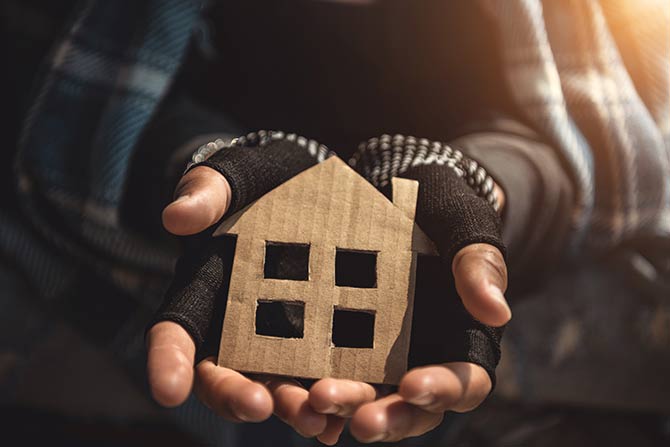David Hockmuth
I want to personally thank our 2022-2023 President, David Hockmuth, for his leadership, counsel, intelligence, sense of humor and fresh ideas throughout his term. Like all CEOs, he is extremely busy, but always found time to deal with NMBA matters. We had a terrific time on our annual legislative road trip, driving around in his cool BMW. We had some mishaps along the way — only to be saved by Sheila Mathews and Max Myers. Sparing no expense, we stayed at a few hotels in which David noted, “At least we finally have hot water!”
Above all, I want to thank David for his friendship, his unwavering support and for agreeing to be our President after a rather pricey fast food lunch on me.
Housing and Homelessness
With more than half a million people unhoused, including 100,000 children, the United States continues to struggle to solve the homelessness crisis. Homelessness is not a new issue but is one that often doesn’t receive a great deal of attention. The number of Americans living without homes, in shelters or on the streets continues to rise in many areas of the country at an alarming rate.
Homelessness is often difficult to document. The same pandemic conditions that almost destroyed the U.S. economy and disproportionately impacted the most vulnerable kept the government from accurately counting the homeless population. Following a period of limited data, HUD recently completed its first Comprehensive Annual Homelessness Assessment Report in two years. It found approximately 600,000 persons are unhoused on any given night — a slight increase over pre-COVID numbers. While overall numbers were relatively stable during COVID, some demographics shifted substantially. Key findings of the report include:
- 582,462 individuals are experiencing homelessness in the U.S. census conducted in 2020.
- About 30% of people without homes are experiencing chronic patterns of homelessness. This means they’ve been without homes for more than 12 months or have experienced extended periods of extended homelessness over the past three years.
- Most states saw their homeless populations rise since 2019, including four where the tally more than doubled (Delaware, Vermont, Louisiana, Maine).
- Sixty percent of individuals experiencing homelessness are male, though unsheltered homelessness rose by 5% among women and girls. More than a quarter of those experiencing homelessness were with their families and children.
- Much progress has been made in reducing homelessness among military veterans. Homelessness in this population declined by 11% over the past two years and has been halved since 2010.
No factor matters more than access to housing. Poverty, mental illness and addiction do play roles, but they are less significant than housing. Housing researchers use the example of musical chairs: Imagine there are 10 people for nine chairs. One person, weighed down by poor health, does not make it to a chair. Is the problem with that person’s health or the lack of chairs? Homelessness, then, is a supply-and-demand problem. Without enough housing, not everyone has a place to live. And the homes that do exist cost more as people compete for limited supply. So more people are priced out and more end up homeless.
Locally, the New Mexico Coalition to End Homelessness estimates there are 19,000-20,000 homeless people throughout the year in the state. The percentage of New Mexico’s homeless population by category includes 43.3% — families with children; 7.8% — unaccompanied homeless youth; 5.1% — veterans; and 40% — chronically homeless individuals. When comparing homelessness by gender in our state, 44.14% are female and 52.88% male. Finally, when comparing by age: 5.6% — under 5 years old; 9.2% — 5 to 13 years old; 5.7% — 13 to 17 years old; 7.2% — 18 to 24 years old; 15.8% — 25 to 34 years old; 19.6% — 35 to 44 years old; 15.3% — 45 to 54 years old; 10% — 55 to 61 years old; and 8.2% — 62+ years old.
So, what are we doing and what can we do in New Mexico to alleviate the homelessness crisis? The New Mexico Mortgage Finance Authority (MFA), the state’s Housing Authority, has made great progress in establishing a roadmap for handling the homelessness issue. In 2022, for homelessness assistance and prevention, more than 5,075 people experiencing homelessness or at imminent risk of experiencing homelessness received housing assistance from MFA’s nonprofit partners. MFA’s funding to those partners totaled $4.9 million. Homelessness was prevented for 935 individuals who received just over $3.1 million in MFA-funded rental assistance.
The MFA has developed a call to action to create a stable housing environment for persons experiencing homelessness and with special needs. The actions will address the following:
- New Mexico needs to expand its range of evidence-proven and housing+services models, tailored to local needs, to address homelessness.
- Urban areas need both site-based and scattered site models. Predevelopment funding, developer capacity, deeper subsidies and adequate and consistent supportive services are needed to create successful exits from homelessness.
- Small (less than 30 units) housing+services developments or scattered site developments are often the best solution in rural counties, yet funding favors larger developments. Rural areas need adequate and consistent supportive services for small and scattered site single-family homes.
- Lack of a comprehensive behavioral health care system makes it difficult for housing providers, including private sector property managers, to address the complex needs of tenants. Providers may not recognize the behavioral health needs of residents and be unsure of how to properly address challenges, perpetuating the cycle of housing instability.









